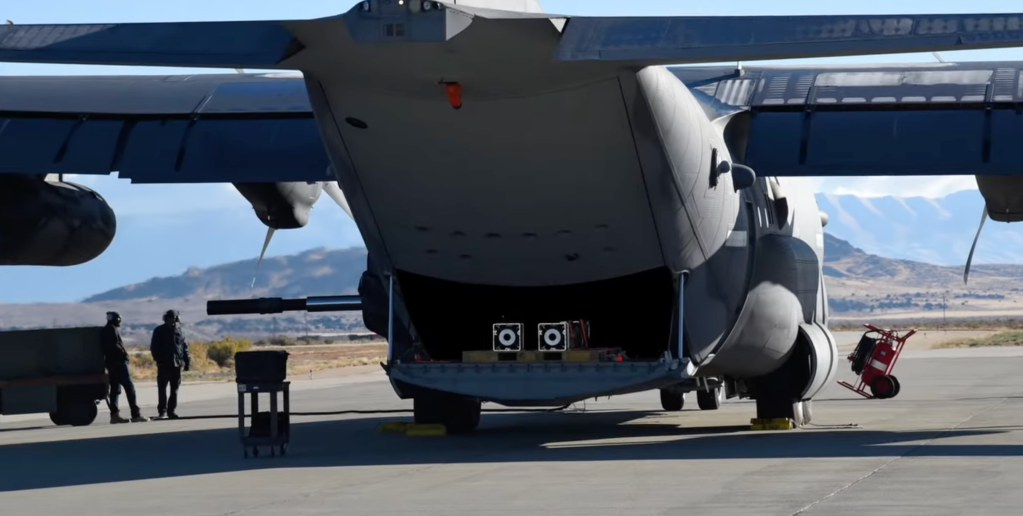Tiny Black Arrow Cruise Missile Demonstrates A Whopping 400-Mile Range
The Black Arrow, also known as the Small Cruise Missile (SCM), flew for more than 400 nautical miles in a test earlier this summer. Leidos disclosed the milestone to TWZ and also raised the possibility of eventually integrating the missile with the MQ-9 Reaper drone and the OA-1K Skyraider II light attack aircraft. As we have discussed in the past, the size and weight of Black Arrow render it suitable for carriage by a wide range of platforms, including drones, while its demonstrated range puts it very much in a class of its own.
Discussing the Black Arrow program with TWZ at the Air, Space & Cyber Conference in National Harbor, Maryland, Mark Miller, senior vice president for Missile and Aviation Systems at Leidos, stated that the 400-nautical-mile barrier had been broken in late July, during an envelope-expansion test for the missile carried out from a version of the C-130 transport. Just for context, although wildly different in basic features, that is just under double the range of the original AGM-158 JASSM air-launched cruise missile, and about 70 percent as long as the new extended-range JASSM-ER model. It’s also roughly 10 times the range of an unpowered Small Diameter Bomb.

Back in 2021, when U.S. Special Operations Command (SOCOM) issued a contracting notice regarding a Stand-Off Precision Guided Weapon Program Cruise Missile, outlining interest in a weapon of this type, the specifications included a range of between 200 and 400 nautical miles (around 230 and 460 miles).
As well as demonstrating its range performance, the July Black Arrow test saw the missile “navigate several thousands of feet of altitude change,” expanding the envelope compared to prior testing.
Prior testing includes launch from an AC-130J Ghostrider gunship in November of last year, something you can read more about here.

“Key performance metrics included maneuverability, climbing and descent performance, waypoint guidance, navigation accuracy, and — very important —integration with the Naval Surface Warfare Center Battle Management System,” Miller added.
The roughly 200-pound munition has, so far, been tested from C-130 variants but offers the kinds of capabilities that SOCOM is increasingly looking at harnessing. Miller confirmed that the company was now looking at integrating it on different special operations aircraft, including the MQ-9 and OA-1K. Adding standoff strike capabilities to aircraft like these is seen as a critical way to ensure their relevance, especially in more contested airspace.

Notably, adding the Black Arrow to the MQ-9 or OA-1K would create a true standoff weapons delivery platform, meaning that strikes could be launched outside the range of even long-range enemy air defenses.

“Between the modularity, between the relevant testing we’ve done to date, to include integration with a battle management system, we think there’s a pathway to [integrating Black Arrow on] multiple platforms, and we look forward to proliferating it,” Miller said.
Miller said that the fact that the Black Arrow is already being tested “on a government range, on a government aircraft, integrated into a government battle management system” should provide an advantage over other affordable cruise missile designs that are currently proliferating.
So far, the Black Arrow tests have involved “various iterations” of launch tubes on the C-130’s ramp, but future integration on the MQ-9 and OA-1K would require a different launch method. Miller said there is a “clear pathway to multiple different kinds of [launch] configurations, whether it’s pallets, bomb rack units, etc., those are all part of the future discussions for this capability.”
As for pallets, Miller confirmed that the company is working on several concepts, including a modularized container, as well as “other kinds of palletized options … that will obviously vary across platforms as well.”
Miller was not willing to provide a specific timeline update on the program but told TWZ that the Black Arrow is “moving along according to an aggressive schedule.”

Meanwhile, Col. T. Justin Bronder, program executive officer-fixed wing at SOCOM, told TWZ that “There’s certainly a need for sort of this type of long-range capability across the spectrum of both SOF and service platforms.” He added: “We’re certainly looking at all options.”
Bronder also reflected upon the specific need to modernize the air-launched weapons available to Air Force Special Operations Command (AFSOC) platforms:
“If you look at the suite of munitions in my fixed-wing portfolio, battle-proven munitions in service with the Special Operations community, they’re largely optimized around the type of fight Special Operations have been in for the past 20 years. Fairly benign environments, uncontested, closer ranges. As we look at how to maintain and adapt to keep the Special Operations Forces relevant in these future, contested, and denied environments, something like greater standoff is obviously a key attribute to consider. There’s obviously a number of programs across the department looking at longer-range affordable munitions just for that purpose.”

At the Air, Space & Cyber Conference today, TWZ also spoke to Lt. Gen. Michael E. Conley, the AFSOC commander, for his thoughts on arming the OA-1K with the Black Arrow specifically:
“The beauty of the OA-1K is that it’s modular, it’s adaptable, and for a relatively small aircraft can carry a lot of payload. And so in a perfect world, in a resource-unconstrained world, I want to be able to have as big a menu as possible of things that I could hang from a hardpoint on there, or attach as a sensor. So I absolutely see a desire to have [Black Arrow], but not just with OA-1Ks. I’d love to be able to use long-range standoff mission munitions on multiple airframes.”
Conley added that the Black Arrow is, at this point, “the biggest effort we have going right now.”

The Black Arrow also arrives on the scene at a time when the Pentagon is increasingly looking at the potential of lower-cost weapons that can be readily produced at scale to meet the likely demands of future conflicts.
The Collaborative Research and Development (CRADA) program for the Black Arrow, then known as the Small Cruise Missile, began in 2022 under an agreement between Leidos, SOCOM, and AFSOC.
Two years later, SOCOM was publicly stating that the Black Arrow was one of its top priorities and could be launched from the MC-130J Commando II special operations tanker/transport aircraft, as well as the AC-130J, and potentially other platforms.
Now, it seems, we might well be seeing the Black Arrow in the future on the MQ-9 and OA-1K. At the same time, should it prove successful, it’s hard to imagine it won’t migrate to other, more traditional platforms, such as bombers and even fighters.
Contact the author: [email protected]







